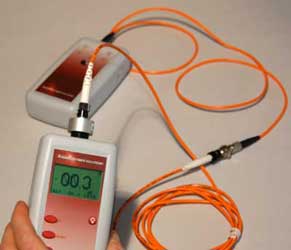The latest optical fibre testing equipment improves troubleshooting and diagnostics in telecommunications.
Wiki Article
Checking Out the Benefits of Optical Fiber Testing for Improved Communication Systems
The relevance of optical fiber screening in contemporary interaction systems can not be overemphasized, as it offers as a foundation for making certain network reliability and efficiency. This aggressive screening technique has profound implications for signal high quality and functional performance, increasing the inquiry of how these techniques add to long-lasting sustainability in an ever-evolving technical landscape.Importance of Optical Fibre Screening
The importance of optical fibre screening can not be overemphasized in today's data-driven setting. As organizations progressively count on high-speed information transmission for everyday operations, the integrity and performance of optical fiber networks are critical. Checking ensures that these networks can sustain the vast quantities of information created and transmitted seamlessly, promoting effective communication and connectivity.Optical fibre testing offers numerous essential features, consisting of verifying installation top quality, recognizing potential faults, and establishing general system efficiency. Regular testing can prevent expensive downtimes and service disruptions, permitting companies to maintain functional continuity. Additionally, it aids in conformity with industry criteria and guidelines, guaranteeing that fiber optic installments satisfy required specs for safety and integrity.
In addition, testing can enhance the durability of fiber optic systems. By proactively recognizing issues such as signal loss, depletion, or adapter failures, organizations can address issues prior to they escalate, therefore expanding the life of their infrastructure. In recap, optical fibre testing is not merely a technological requirement yet a strategic financial investment that improves network dependability, optimizes efficiency, and eventually supports the growth and efficiency of modern-day interaction systems.
Trick Testing Techniques

OTDR is a vital technique utilized to recognize mistakes, step splice losses, and examine the general integrity of a fibre optic link. By sending a pulse of light down the fibre and evaluating the shown light, technicians can pinpoint areas of mistakes and examine the network's efficiency over lengthy ranges.
Insertion loss screening determines the quantity of signal loss that takes place when light go through a connection or splice. This technique is vital for verifying that connections meet given loss limits, which is important for maintaining ideal efficiency in interaction systems.
Optical return loss screening evaluates the amount of light mirrored back in the direction of the resource as a result of blemishes in the fibre or connections. High return loss worths show much better efficiency and reduced signal deterioration.
With each other, these testing methods provide an extensive evaluation of fibre optic networks, ensuring their reliability and functionality in varied interaction applications.
Influence On System Efficiency
Efficient optical fibre testing straight affects the overall performance of interaction systems. By making sure the honesty of fiber optic cables, testing identifies possible mistakes such as depletion, splice loss, and port misalignment. These issues can dramatically break down signal high quality, bring about disturbances and reduced information transmission speeds.
In addition, regular optical fiber testing adds to lasting system sustainability. It makes it possible for early discovery of wear and tear, enabling timely maintenance and upgrades prior to significant failures occur. This not just prolongs the life-span of the facilities yet also guarantees that interaction systems remain competitive in regards to efficiency.
Cost-Effectiveness and Efficiency
Cost-effectiveness is a vital consideration in the implementation and upkeep of optical fibre networks. Implementing robust optical fibre testing treatments can significantly lower functional costs by determining concerns before they rise right into major issues. optical fibre testing equipment. By spotting faults, attenuation, and other performance barriers early, companies can avoid expensive repair work and downtime, which can interfere with solutions and result in revenue lossAdditionally, effective screening approaches streamline the installment process, allowing professionals to work better. This converts to lower work expenses and faster job conclusion times. Advanced testing equipment, such as Optical Time Domain Reflectometers (OTDRs), enables a specific assessment of fibre quality, ensuring that only ideal materials are made use of, thus decreasing waste.
Routine screening also adds to far better source allowance. By understanding the network's performance, companies can make enlightened decisions about upgrades and growths, guaranteeing that investments are made where they are most required. In summary, optical fiber screening boosts cost-effectiveness and efficiency, supporting the long-lasting sustainability and competitiveness of interaction systems in a progressively demanding market.
Guaranteeing Long-Term Integrity
Applying strenuous optical fibre testing not just boosts expense financial savings and functional effectiveness however additionally plays an essential function in guaranteeing the long-term integrity of interaction networks. Consistent screening practices, including depletion and transmission capacity assessments, help recognize potential destruction in fibre efficiency before it causes solution interruptions.By using advanced screening methodologies, network operators can pinpoint mistakes or weak points in the fiber facilities, permitting for prompt removal. This aggressive optical fibre diameter analyser strategy decreases downtime, ensuring that communication systems remain functional and efficient. Normal testing adds to the growth of a much more resilient network, as operators can adapt and optimize their framework based on real-time data understandings.
Furthermore, making certain conformity with industry standards via optical fiber testing reinforces the top quality and stability of the entire interaction system. This adherence not just reinforces confidence amongst stakeholders however likewise lines up with regulative requirements, which are significantly strict.
Final Thought
In conclusion, optical fibre testing offers as a basic component in improving interaction systems. By employing different screening approaches, such as OTDR and insertion loss assessments, networks can accomplish optimum performance and integrity.Report this wiki page